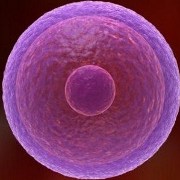 Photo: Getty Images
Photo: Getty Images
The ovaries, which are glands, are important parts of the female reproductive system. There are typically two of them. Located within the pelvis, they are found on each side of the uterus above the fallopian tubes and are held in place by connective tissue. Some say they’re the size of almonds. Others say olives. Suffice it to say, they’re small.
According to Catholic Health, the ovaries have two functions. One is to produce the female hormones estrogen and progesterone, which help regulate a woman's menstrual cycle and produce testosterone, which helps with the sex drive. John Hopkins Pathology goes on to say these hormones also regulate pregnancy and the development of a woman's physical appearance including breasts, shape and hair.
The second job of the ovaries is to produce eggs. Catholic Health says eggs grow, develop, and mature in the follicles of the ovaries and then are released during ovulation. That’s part of the monthly menstrual cycle that occurs during the childbearing years.
Leaving the ovary, the egg makes its way into one of the fallopian tubes. If the egg is fertilized by sperm, it takes a few days traveling down the fallopian tube. Then it attaches to the thick, blood-rich lining of the uterus. If fertilization doesn’t take place, the egg falls apart, estrogen and progesterone levels drop, and the uterine lining breaks down and sheds during the woman's next period.
Here’s an interesting fact. Women are born with nearly one million egg follicles in each ovary. By their first period, the number of immature eggs in each is around 400,000 to 450,000. During childbearing years, approximately 400 to 450 eggs develop and are released during ovulation. After menopause, ovaries stop producing eggs and shrink.
Like most organs, ovaries can have problems. Cysts can grow on ovaries. According to an article in WomensHealth.About.com, ovarian cysts are fluid-filled sacs, similar to blisters. They are common among women during their reproductive years. Most types of ovarian cysts are harmless and go away without any treatment.
Another ovary concern is ovarian cancer. The WomensHealth.about.com article goes on to say, ovarian cancer is often called the "silent" killer because many times there are no symptoms until the disease has progressed to an advanced stage.
An annual pelvic exam allows the doctor to check the ovaries to take note of their size and shape. The healthcare provider can then detect if the ovaries are enlarged, have cysts or if a mass has formed.
Sources:
Ovary 101: What You Need to Know About Your Ovaries
http://womenshealth.about.com/cs/ovarianconditions/a/yrovrisovuovads.htm
The Ovaries
http://www.stayinginshape.com/3chsbuffalo/libv/c03.shtml
Ovarian Cancer
http://www.ovariancancer.jhmi.edu/anatphys.cfm
Ovarian Cancer
http://www.ncbi.nlm.nih.gov/pubmedhealth/PMH0001891/
New World Encyclopedia: Menstruation. accessed Aug 4, 2011 at
http://www.newworldencyclopedia.org/entry/Menstrual_cycle
Reviewed August 5, 2011
by Michele Blacksberg R.N.
Edited by Jody Smith





Add a CommentComments
There are no comments yet. Be the first one and get the conversation started!